RASL
In the 1990s I stepped away from comics for a while. Not entirely, sure, but I did stem my weekly habit of visiting my local supplier every Wednesday to pick through the new releases. I got kind of burnt out on the whole scene during that era. To fill the narrative hole left by my newfound and half-hearted abstinence, I turned to film.
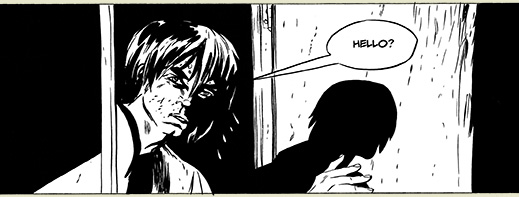 Hey there.
Hey there.
The '90s were when it became more common for films to appear on VHS mere months after cinematic release—and at a reasonable price too!11For a long while, video releases weren't intended to go straight to the consumer and were marketed to video rental houses. Purchasing a new cassette (for, say, that colossal bastion of taste and refinement, D.B. Sweeney's and Moira Kelley's rocket to A-list stardom, The Cutting Edge), would cost more than a brand-new game Xbox 360. It wasn't until the early '90s that it became common to see VHS movies released at price points near $20. Which I know because when I wanted to buy Last of the Mohicans, it was like $80 and so brought about my first act of piracy, renting the film and then duping it with a second VCR. Scandalous! Then came DVD and my fair-sized film collection grew obscene as I reveled in the joys of directors' cuts, feature-length commentary, and all the bells-and-whistles that studios used to entice collectors back then. (Note: the early days of DVD were fertile for film lovers for all the bonus features packed into discs.) I began to consider myself a true cineaste.
Of all the modes and genres, the kind of film I found myself returning to most frequently was film noir. It was something in the alchemy of sight and sound unique to noir that won me over—that striking admixture of the stark lights and darks, the snappy hard-boiled cryptolect, the femme fatale, the hard-bitten antihero, and the existential journey that governs the mode. I devoured every piece of noir cinema I could find: the real stuff in the range of 1941 through 1958, the proto-noir police procedurals, the neo-noir homages (e.g. Chinatown or Phoenix), and even the sci-fi noirs (e.g. Bladerunner and Dark City). I read books on the subject, both popular (like Eddie Muller's Dark City) and academic (such as the wonderful Alain-Silver-and-James-Ursini-edited series of essays, Film Noir Reader). All that is to say, I bear at least some small affection for noir, and when I returned to comics after my decade-long sabbatical I would have been pleased as a bourbon-spiked punch to encounter something in the mode in the comics medium.
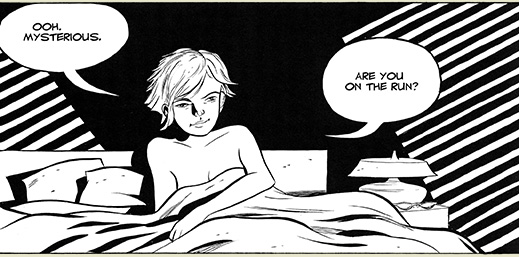 Not from you, apparently.
Not from you, apparently.
Unfortunately, even in the world of black-and-white crime comics, the essence of noir seems incredibly difficult to achieve. There are certainly many good crime comics, but not a lot that even come near to successfully capturing the unique chemistry of noir. Perhaps the closest I've seen is MISS: Better Living Through Crime—which, while eschewing any number of the normative elements of the mode, still manages to exude the necessary vibe. Dave Lapham's Murder Me Dead (and to lesser degree Stray Bullets) also falls pretty safely under the noir label—it even has a so-very-noir title. Beyond that, really, I've only so much encountered books that were influenced by noir rather than noir proper. And that's okay.
Jeff Smith's RASL is sometimes billed as sci-fi noir but is really only sci-fi that's influenced by noir. And that's okay. It's okay because, for the most part, the book is really good. And at the end of the day, even if the thing you want more than anything is Billy Madison 2, you're still gonna be pretty happy if you get Last of the Mohicans instead. Apple? Orange? Who cares so long as it's tasty and refreshing.
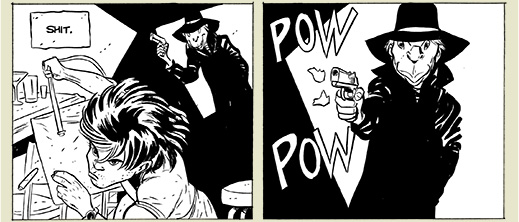 If rob had a gun here, one of these men would have bullets in them.
If rob had a gun here, one of these men would have bullets in them.
After Smith tidied up the Bone universe in 2004, he made a brief pit-stop over at DC Comics where he produced a short Captain Marvel story for the company. It was good and it was fine but what everyone wanted was more of Jeff Smith and what his own fertile imagination could concoct. Then Smith began producing RASL and everyone promptly forgot about him. At least so far as anything beyond Bone went. Or at least so far as I was aware. Granted, I'm only vaguely cognizant of anything going on in the comics world, but I do regularly read Greg Burgas over at Comics Should Be Good and occasionally read some of his cohorts at the same site. And I stopped visiting my local comics store a couple years before the first chapter was released. So who knows. Maybe RASL was all the rage and I just never heard about it.
At any rate, I was surprised to find out last November that the series had concluded and was collected in four handsome volumes. I immediately amended my Christmas list and sent RASL right to the top. I needed to see whether the lack of news was justified. After all, Bone turned Smith into one of my (and my wife's) favourite creators. It turned out that I needn't have worried and that even though RASL was merely influenced by noir and not the real deal, it was still pretty great.
 You got your science in my fiction! You got your fiction in my science!
You got your science in my fiction! You got your fiction in my science!
Two great tastes that taste great together!
One of the most immediately discernible positives about Smith's book is the art. If you were a fan of Bone's illustrations, you'll be right at home in RASL. My young daughter saw me reading the book, looked inside, and asked if it was a new volume of Bone. She's three-and-a-half and she could pick out Smith's style at a glance. He's built the book around the same strong use of positive and negative spaces, the same fine-lined figurework and exaggerated postures. And just like Bone was dominated by beautiful pages, so is RASL—even if the New Mexican desert isn't half so lush as Thorn's Valley.
Like his prior opus, this new work allows Smith to explore the divide between the visible and the spiritual, between the empiric and the elusive. The scientist-on-the-lam hero, Rob, is caught between mysteries his methodologies have a chance at explaining and the myths that roam his world unheeding the requirements of physics or the natural laws. He encounters the god he trusts, Nikola Tesla, through diaries, journals, and academic papers. He blunders into a god he'll never understand through simple acts of providence. Whether he encounters the divine or not is something that Rob is not equipped to discern. And in the end it doesn't really matter. After all, this is a thriller, dammit, and Rob's trajectory and the conventions of his narrative will not allow us to dwell overlong on philosophy or metaphysics.
We can't forget that Smith is modeling Rob's journey on the comfortable formulae so native to the noirish mode. Rob's a dirty angel, but he's our angel. He's morally tarnished (and was so even before he went off the grid to flee a government bent on information and revenge), stealing art and shacking up with a prostitute. He's a man of deep appetites and his use of Tesla-inspired world-skipping technologies only serves to enlarge his antiheroism and needs.
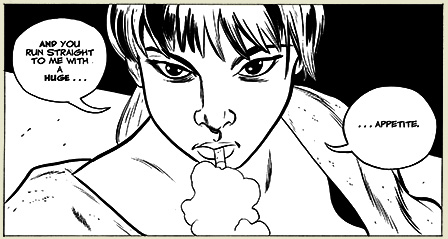 Hither and come.
Hither and come.
And as much as he's caught between science and spirit, Rob finds himself wedged between any number of other duets. Some abstract, others less so. Tormented by the ghost of a scientist and the ghost of a woman. Crushed between his rational mind and his hungering passions. Full-bodied romance and the stale whiskey of base desire. Selfishness and sacrifice. He's the hooker with a heart of gold, only he's selling his soul instead of his body. He could be a character out of Chandler if only he had a chance with the snappy patter. He's hard-boiled alright, but not much of a talker. He's closer to John McClane than he is to Philip Marlowe.
Still, thankfully, it isn't Smith's occasional nods to noir that won me over so soundly. It was Tesla. It didn't have to be him, exactly. It could have been Marconi or Edison or Lodge or Einstein or Feynman or Curie or anyone, really. But I love it when fictional stories (especially science fictional stories) take members of the historical record and insert them into the novel in a big way. It has to be believable, of course, but I find that when done well these inclusions add an automatic sense of reality to what might otherwise be a wholly fantastic story. And Smith does it well here.
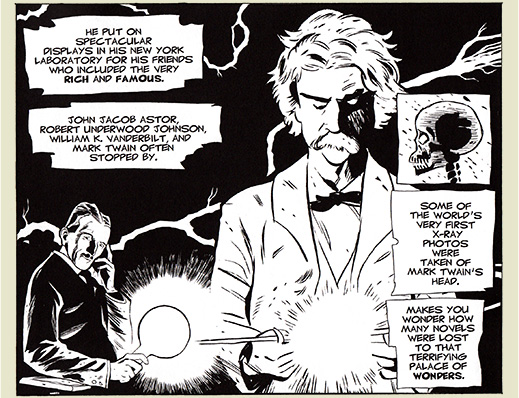 My tenth grade self is thankful, as there was only so much Twain he could stand.
My tenth grade self is thankful, as there was only so much Twain he could stand.
Nikola Tesla has, in the past few years, enjoyed a popular renaissance. He's become the scientific hero that primitive man a century ago was too short-sighted to see. For at least the last three-or-so years, content aggregators like Reddit have humped the leg of his ghost and legend so hard that his spirit's got to haunt with a limp now. And RASL comes, coincidentally, at the perfect time for all this adulation. Really, if sites like Reddit need to make a patron saint of a comic book, the book should be RASL, hands down. The man, while seventy-five years dead at the time of Rob's story, is the hero of the book while Rob skulks around as mere protagonist. We follow Rob but our eyes, like his, are always on Tesla. And that's a pretty mighty accomplishment on Smith's part.
The book, for all its wonders, is not without flaw. As he did with Bone, Smith seems to have an aversion to wrapping things up in a way that satisfies. RASL definitely leaves less to the hands of the authors of fan fiction, but there are a couple large questions that remain unanswered. I'm okay with living with the mystery, but at the same time I would have probably been more okay with the solution. But then, perhaps like Rob, I too have less patience for the invisible when there's so much concrete laid out before me.
Good Ok Bad features reviews of comics, graphic novels, manga, et cetera using a rare and auspicious three-star rating system. Point systems are notoriously fiddly, so here it's been pared down to three simple possibilities:
3 Stars = Good
2 Stars = Ok
1 Star = Bad
I am Seth T. Hahne and these are my reviews.
Browse Reviews By
Other Features
- Best Books of the Year:
- Top 50 of 2024
- Top 50 of 2023
- Top 100 of 2020-22
- Top 75 of 2019
- Top 50 of 2018
- Top 75 of 2017
- Top 75 of 2016
- Top 75 of 2015
- Top 75 of 2014
- Top 35 of 2013
- Top 25 of 2012
- Top 10 of 2011
- Popular Sections:
- All-Time Top 500
- All the Boardgames I've Played
- All the Anime Series I've Seen
- All the Animated Films I've Seen
- Top 75 by Female Creators
- Kids Recommendations
- What I Read: A Reading Log
- Other Features:
- Bookclub Study Guides










